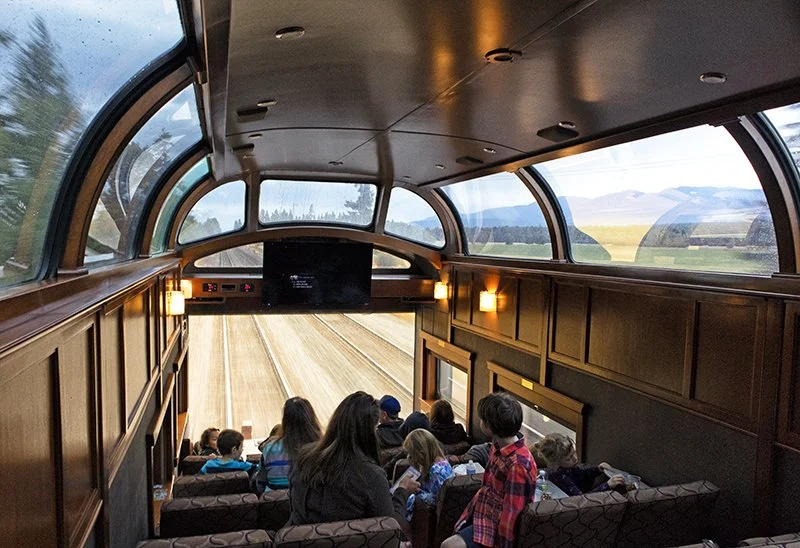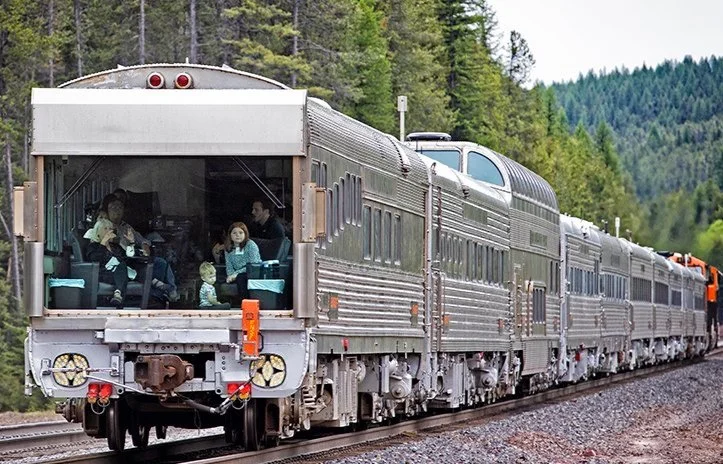The BNSF Special: A Guide to One of BNSF Railways' Most Scenic Routes
Where can you see smiling faces, adults who act like kids, children whose mouths gape in awe and an overall happy environment? no, it isn’t Disneyland, but the BNSF Railway Special.
For 10 years, the Special has given the young and the young at heart a chance to tour routes –sometimes remote – across the BNSF system. For many, these are a rare treat; most people don’t get an opportunity to ride a BNSF passenger train, much less witness such scenic landscapes as Cajon Pass in Southern California or experience BNSF’s busy Transcontinental line (Transcon).
For those who have not yet experienced it, tMcDThe railcars are pulled by two diesel-electric locomotives. This year’s Special completed a 5,000-mile journey with stops in New Mexico, Arizona and California between June 5 and June 25.
A History of Success
In 1996, the Special began as a tribute to and in appreciation of employees, allowing them to share with their family members some of their everyday experiences at BNSF. Each year, the Special tours different regions so all employees have a chance to enjoy the ride as it travels across BNSF’s vast network. As was evident by all the smiling faces on this year’s trip, everyone of the 7,000 passengers appreciated the chance to be on the Special.
“For me this trip was very important,” says R.E. Henderson, signal technician, Dispatching
Center, San Bernardino, Calif. “Most of the time my family is only able to hear about my job, but with the BNSF Special, they can see it for themselves.”
Kenneth Peterson, retired, San Bernardino, says bringing his three grandchildren was a real-life learning tool. “It is educational in every way,” says Peterson. “Plus, trains go places that a highway can’t, so this gives us all a new view of things.”
“It’s a good break from the heat, and we are having a great time,” says Wes Harris, a two-year conductor, Phoenix, while on board.
JJ Magana III, an engineer of 10 years, Phoenix, accompanied perhaps one of the youngest passengers ever to board the BNSF Special. Joey Magana, a 2-week-old baby, quietly slept in his mother’s arms. He wasn’t quite as excited about the trip as was his 4-year-old brother, Jesse, who showed enough enthusiasm about the train ride for the both of them.
“What a wonderful opportunity for the employees to have their families spend time on a passenger train traversing a portion of the subdivisions where they work,” says Larry Kreger, superintendent of Operations, Winslow, Ariz., on the Southwest Division. “They were able to explain various aspects of their job to their families, so they can better understand what it is they do for a living and the role they play as an integral link in the transportation of goods across the world.” In addition, the Special visited the California and Los Angeles divisions. Says Joe Faust, regional director, Public Affairs, BNSF: “We’re pleased to support an endeavor such as this to thank our employees for a job well done as well as acknowledge the role their families contribute to that effort.”
The Special also entertains customers, community members and youth from the local Boys & Girls Clubs. Since 2002, BNSF has partnered with Boys & Girls Clubs of America to raise funds and give children the opportunity to ride the Special. This year, again, the BNSF Foundation pledged donations to the Boys & Girls Clubs national office and local chapters in five cities along the route.
Special Challenges
The passengers are just one part of the BNSF Special’s story. The crew is the other important piece. For 10 years, the Special has had a smooth run thanks to the staff, which includes more than 20 BNSF employees and contractors.
There are cooks, housekeepers, ticket handlers and servers on board to meet the needs of passengers. There is also an emergency medical technician to assist anyone who may need medical assistance.
One of the toughest jobs may be cooking; the chef has to make meals for BNSF staff, invited customers and other guests. “Developing a menu for an entire crew with a lot of variety is tough,” says Shawn Bravence, crew chef.
“The passengers are great. Some rarely have this type of experience, so there’s a high level of excitement. They are very appreciative of the Special,” says Micha Rigmaiden, staff member on the Special, adding that the toughest part of the trip for her is living on the train for a month.
From the passengers’ point of view, it may seem like everything goes off without a hitch, but there are many challenges along the way that may potentially take the Special off track.
“It’s like running hurdles, and you know eventually another is coming,” says Jeff Schmid, manager, Field Safety Support, who has been an integral part of the BNSF Special for 10 years.
He adds the key to managing the challenges is good planning and being flexible. Schmid plans and scouts the trips several months in advance. He has to anticipate numerous factors before the train ever comes to a location.
The first portion of planning is typically handled by a regional vice president and general managers, says Schmid. Once they have approved a general route, they communicate to their staff that the Special will operate in their territory and assign a person to work with Schmid, who then travels to each location to determine needs and logistical data.
Schmid’s pre-trip research includes finding storage for a 1,300-foot train and a boarding site with good footing and enough parking for visitors. Also, the availability of services such as water, fuel, septic service for the bathrooms, ice, trash pickup and security are huge considerations.
New Territory
This year, the Special charted new territory, covering much of the Southern Transcon. (The Transcon is BNSF’s 2,227-mile line connecting Chicago to Long Beach, Calif., a key West Coast entry for container ships carrying consumer goods.)
“The 2006 Special was arguably the most challenging of any Special in recent years,” says Schmid. “Operational and climate factors were the most extreme ever. However, despite the difficulties, the 2006 Special was a great success.”
Says Chris Roberts, vice president, southern region: “Many of the segments this year’s Special operated over handle as many as 100 trains per day. The 2006 Special was a great success due to the planning and participation of everyone involved.”
“We needed to consider our current operation and ensure we could adequately do both [passenger and freight operations],” says Chuck Potempa, terminal superintendent, Hobart facility. “We not only wanted to take care of our customers, but also our employees, who we depend on every day.”
Adds Matthew Garland, terminal manager, Bakersfield, Calif.: “Planning the event in advance and communicating the needs of our team were crucial.
The staff on the Special was fantastic and provided great support. Every member of this team went out of their way to ensure a smooth operation.”
This year’s schedule had to be carefully crafted to accommodate school calendars in the Southwest due to the school year running well into June in some areas. “If possible, we want the trips to operate after school is out for the summer,” says Schmid.
It All Works Out
No matter how much planning is done, obstacles can still change scheduled events. For example, one portion of this year’s trip had to be canceled due to a derailment.
“One Boys & Girls Club trip and an employee trip were canceled because of a freight derailment, which prevented the train from traveling to Fresno, Calif.,” says Schmid, who faced other challenges.
“Given the extreme freight traffic volumes and the need to avoid Amtrak conflicts, the schedule performance was excellent,” says Schmid. “Inevitably, there are last-minute details and unforeseen circumstances. Even after the trip is under way, I’m on the phone with various terminals, answering questions and accommodating problems, suggestions or requests. Amazingly, it all works out.”
Because the Special requires frequent mechanical maintenance and required checkups, two Mechanical personnel are on the train 24 hours a day. They often handle daily needs such as fuel, water, toilet retention tank pump-out and trash pickup.
“The two Mechanical employees [Mike Cairo and Bob Koozer, who is soon to retire] were excellent in addressing problems,” says Schmid. “The equipment performed very well given the intensity of use and extreme heat, which exceeded 100 degrees during eight days of the tour. Air conditioning only failed in one coach on one trip, and passengers were quickly moved to other coaches.”
“Having proven that the Special can operate successfully on the Transcon, it can almost certainly operate anywhere else on BNSF,”says Schmid. “The reward for all of us is the thousands of passenger smiles on the trips, and the thanks as they depart the train.”
The published article may also be found on www.bnsf.com. Written by Ro Hawthorne.


